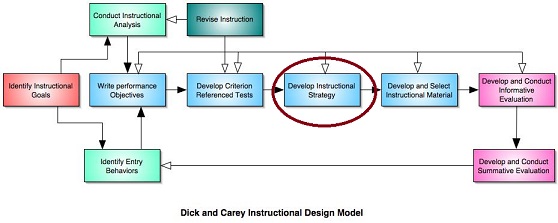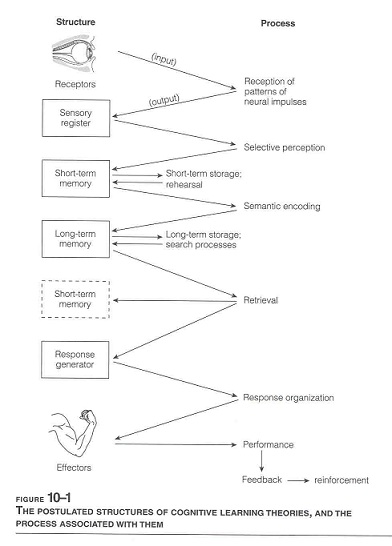Week Nine Instructional Strategies
We are now beginning the next phase of the instructional design process -- developing instructional strategies. The purpose of an instructional strategy is to select the 'best' way to present the material to the learners, a way that maximizes their chances of learning. Instructional strategies have four elements:
- content sequence and clustering
- learning components
- student groupings
- selection of media and delivery systems
Note where we are in the Dick and Carey instructional design process - almost halfway through the model!

Learning Objectives
- Describe considerations in selecting an instructional delivery system.
- Sequence content and arrange it in lesson-level clusters.
- Name the five learning components of an instructional strategy and list the primary considerations within each.
- Develop an instructional strategy, including preinstructional activities, content presentation, learner participation, assessment, and follow-through activities, for a set of objectives for a particular group of learners.
- Develop an instructional strategy congruent with learners' maturity and ability levels and the type of learning outcome.
- Select appropriate student groupings and media for the learning components of an instructional strategy.
Overview
Let's first look at Gagne's 9 Events of Instruction, the classic instructional methodology that when applied well usually results in instruction with high integrity. These are meant for both classroom instruction and self-paced instruction. If instructors or the material itself follow these events, then generally speaking, the instructional quality will be higher.
Gagne's 9 Instructional Events |
1. Gaining attention |
2. Informing learner of objectives |
3. Stimulating recall of prior learning |
4. Presenting the stimulus material |
5. Providing learning guidance |
6. Eliciting the performance |
7. Providing feedback about performance correctness |
8. Assessing the performance |
9. Enhancing retention and transfer |
Once you have an understanding of Gagne's events of instruction and their relationship to instructional strategies, it's time to create an instructional strategy for your instructional unit. I strongly recommend you follow the steps outlined in Dick and Carey on p. 211-212, namely
- sequence and cluster objectives (see Table 8.5 for an example)
- plan the preinstructional activities, assessment, and follow-through (see Table 8.3 for an example)
- plan the content presentation and student participation activities for each objective or cluster of objectives (see Table 8.4 and 8.8 for examples)
- assign objectives to lessons and include time need to teach each lesson (see Table 8.9 for an example
- review the strategy to confirm that media selected is compatible with delivery system or select a delivery system (see Table 8.10 for an example)
Table 1 compares the sequence of Gagne's events of instruction (condensed down to five steps), or how material is presented to learners with the sequence that instructional designers follow for actually creating an instructional strategy.
Table 1. Sequencing of instructional events for learner vs. activities for instructional designer
Sequence of presentation of material to learner |
Sequence of activities for instructional designer |
1. preinstructional activities |
1. sequence and cluster objectives |
2. content presentation |
2. plan preinstructional, assessment and follow through activities |
3. learner participation |
3. plan content presentation |
4. assessment activities |
4. assign objectives to lesson |
5. follow through activities |
5. select/confirm media decisions |
The instructional designer activities 1-4 constitute section 3.2 of assignment 3. Activity 5 should be discussed in section 3.3 of assignment 3.
Comments
Although the textbook does an adequate job describing instructional strategies, it needs more emphasis on both the theory behing Gagne's nine events of instruction and specific strategies for different domains of learning.
Let's start with Gagne, who theorized that in order for learning to take place, the external events of instruction must activate the internal learning processes. Take a look at the graphic below which illustrates the sequence of processing information as postulated by cognitive psychologists and is described in the second column. Note this represents cognitivism.
 |
The stimulation that affects the learner's receptors produces patterns of neural activity that are briefly 'registered' by sensor registers. This information is then changed into a form that is recorded in the short-term memory, where prominent features of the original stimulation are stored. The short-term memory has limited capacity in terms of the number of items that can be held in mind. The items that are so held, however, may be internally rehearsed and, thus, maintained. In a following stage, an important transformation called semantic encoding takes place when the information enters the long-term memory for storage. As its name implies, in this kind of transformation, information is stored according to its meaning. When learner performance is called for, the stored information or skill must be searched for and retrieved. It may then be transformed directly into action by way of a response-generator.
|
Frequently, the retrieved information is recalled to the working memory (another name for short-term memory), where it may be combined with other incoming information to enable encoding of new learned capabilities. Learner performance itself sets in motion a process that depends upon external feedback involving the familiar process of reinforcement. In addition to the learning sequence itself, cognitive theories of learning and memory propose the existence of metacognitive control processes. These are processes that select and set in motion cognitive strategies relevent to learning and remembering. Control process of this sort modify the other information flow processes of the learner. A control process may select a strategy of continued rehearsal of the contents of short-term memory for example, or a cognitive strategy of imagining sentences to be learned. They may exercise control over attention, over the encoding of incoming information, and over the retrieval of what has been stored. Gagne, Wager, Golas, Keller, p. 192-193) |
|
Now, let's look at the events of instruction and their relation to processes of learning, as shown in Table 2. You can see the obvious connection between the instructional event and learning process it is designed to stimulate. Please note that these events of instruction do not necessarily need to be presented in this order, nor do all the events need to be included for each lesson. In some cases, students can provide the activities of an event for themselves, particularly if they are adult learners. For more information on Gagne's theories, see the links under Additional Reading. Again, this is based on cognitive learning theory.
Table 2. Events of Instruction and Their Relation to Processes of Learning
Instructional Event |
Relation to Learning Process |
1. Gaining attention |
Reception of patterns of neural impulses |
2. Informing learner of objectives |
Activating a process of executive control |
3. Stimulating recall of prior learning |
Retrieval of prior learning to working memory |
4. Presenting the stimulus material |
Emphasizing features for selective perception |
5. Providing learning guidance |
Semantic encoding; cues for retrieval |
6. Eliciting the performance |
Activating response organization |
7. Providing feedback about performance correctness |
Establishing reinforcement |
8. Assessing the performance |
Activating retrieval; making reinforcement possible |
9. Enhancing retention and transfer |
Providing cues and strategies for retrieval |
(Gagne, Wager, Golas, Keller, p. 195)
Here are some specific strategies for each of Gagne's domains of learning. Remember that Gagne divided learning into five domains:
- verbal information (declarative knowledge)
- intellectual skills (procedural knowledge)
- discriminations
- concepts (concrete and defined)
- principles (relational rules)
- problem solving (higher order rules)
- procedures (procedural rules)
- cognitive strategies (conditional knowledge)
- organizing
- elaborating
- rehearsing
- monitoring comprehension
- attitudes
- psychomotor skills
Listed below are strategies for verbal information and intellectual skills.
- Verbal information (Declarative knowledge) Labels and names, facts and lists, organized discourse
- cognitive processes - linking, organizing, elaborating
- specific strategies - advance organizers (expository and comparative), epitomes, metaphors, associational techniques (mnemonics, images, analogies), organizational techniques (clustering, chunking, graphic organizers, expository structures), elaboration techniques, rehearsal
- Concept learning (intellectual skill)
- difference between concrete and abstract concepts
- two cognitive processes - generalization and discrimination
- two general strategies - inquiry approach (generative) and expository approach (supplantive)
- specific strategies - advance or comparative organizer, best example or prototype, rational set generator, attribute isolation, matched examples and nonexamples, concept trees, analogies, mnemonics, and imagery
- Principle learning (intellectual skill)
- described by if-then or cause-effect relationship
- two general strategies - inquiry and expository
- specific strategies - demonstrations or scenarios, puzzles, analogies, contrasting examples and nonexamples, mnemonics, applications, and diagrams
- Procedural learning (intellectual skill)
- involves algorithms, rules of thumb, or heuristics
- prerequisite knowledge - concepts
- general strategy - expository
- specific strategies - demonstrations, sequencing and clustering steps, matched examples and nonexamples, elaboration, job aids (checklists, flowcharts), mnemonics, snowballing, backward chaining
- Problem solving (intellectual skill)
- domain specific
- heuristic versus algorithmic (procedural) problem solving
- simple to complex continuum
- prerequisite knowledge - principles, declarative knowledge, and cognitive strategies
- specific strategies - means-ends, difference reduction, working backwards, prototypical problems, think aloud, alternative forms, conceptual models, worked examples, modeling
- macrostrategies - Socratic dialogue, expert systems, elaboration model, simulations, microworlds, anchored instruction, case studies, problem-based learning, cognitive apprenticeships
Required Reading
Chapter 8
Engaging By Design: How Engagement Strategies in Popular Computer and Video Games Can Inform Instructional Design, Dickey, ETRD, 2005
Additional Reading
Reclaiming Instructional Design -- M. David Merrill
Cognitive strategy Excerpted from Chapter 9 of Biehler/Snowman, Psychology Applied to Teaching, 8/e, Houghton
Useful Instructional Strategies
Instructional Strategies from Carnegie Mellon
Instructional Strategies that Teach -- David Merrill (short article and highly recommended)
Assignment
- Post peer-review version of Assignment 3 to deliverables folder by next Monday.
- Create an instructional strategy for your instructional unit -- at least one overall strategy for now.
- Identify your intended delivery system and media and be ready to describe in class.
Online Class Discussion
Monday, 8-9:30 p.m., Eastern time via Webex.
- 8:00-8:30 Introductory discussion with additional discussion on Ch 8 led by Billie.
- 8:30-8:45 Discussion of instructional strategies.
- 8:45-:920 Discussion of your strategies. Be prepared to present 2 or 3 strategies to the class.
- 9:20-9:30 Preview of next week
Please email me with any questions.